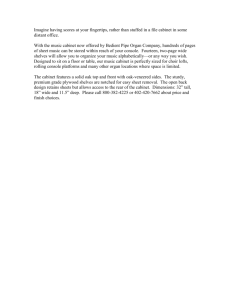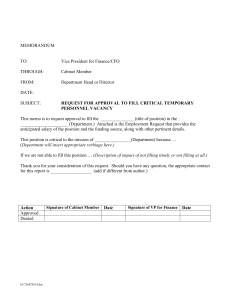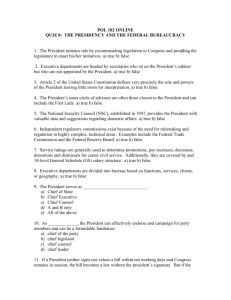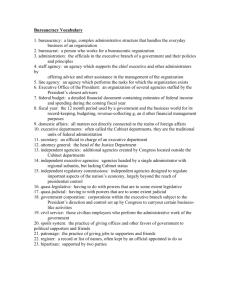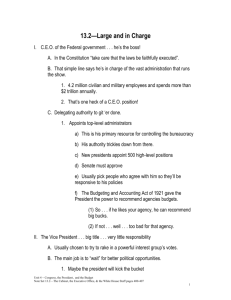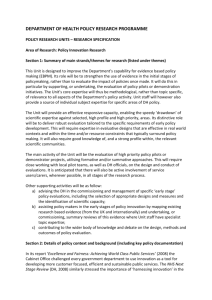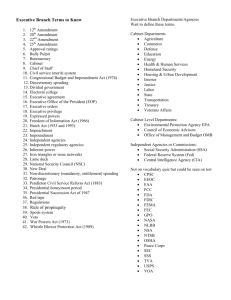Cabinet Scavenger Hunt
advertisement
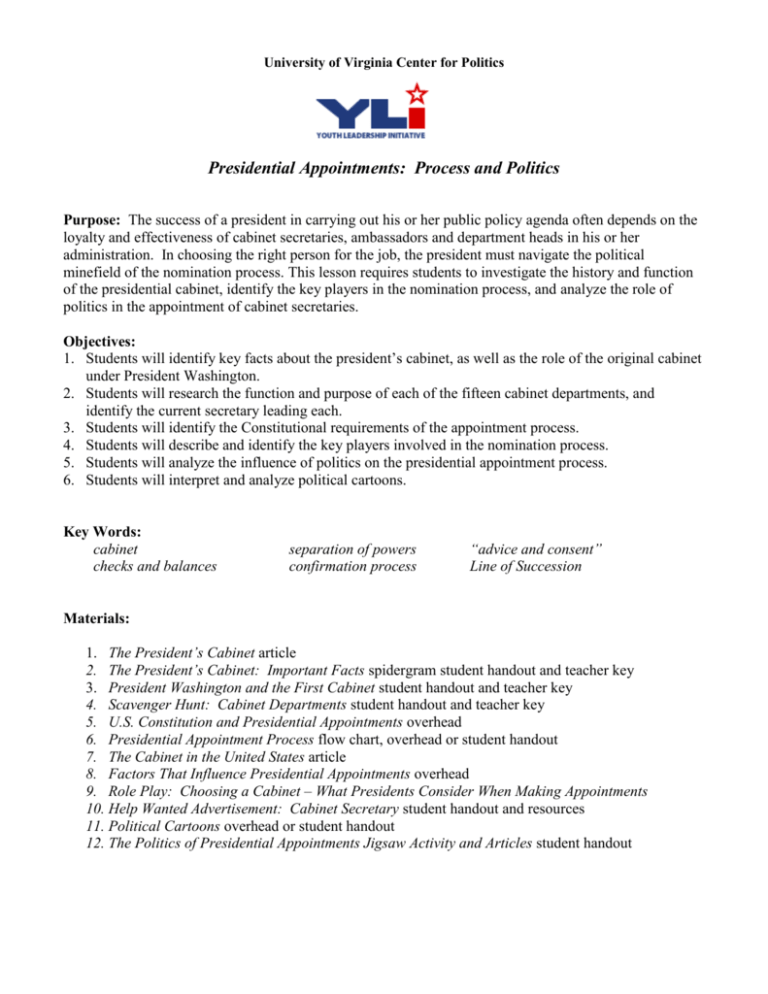
University of Virginia Center for Politics Presidential Appointments: Process and Politics Purpose: The success of a president in carrying out his or her public policy agenda often depends on the loyalty and effectiveness of cabinet secretaries, ambassadors and department heads in his or her administration. In choosing the right person for the job, the president must navigate the political minefield of the nomination process. This lesson requires students to investigate the history and function of the presidential cabinet, identify the key players in the nomination process, and analyze the role of politics in the appointment of cabinet secretaries. Objectives: 1. Students will identify key facts about the president’s cabinet, as well as the role of the original cabinet under President Washington. 2. Students will research the function and purpose of each of the fifteen cabinet departments, and identify the current secretary leading each. 3. Students will identify the Constitutional requirements of the appointment process. 4. Students will describe and identify the key players involved in the nomination process. 5. Students will analyze the influence of politics on the presidential appointment process. 6. Students will interpret and analyze political cartoons. Key Words: cabinet checks and balances separation of powers confirmation process “advice and consent” Line of Succession Materials: 1. The President’s Cabinet article 2. The President’s Cabinet: Important Facts spidergram student handout and teacher key 3. President Washington and the First Cabinet student handout and teacher key 4. Scavenger Hunt: Cabinet Departments student handout and teacher key 5. U.S. Constitution and Presidential Appointments overhead 6. Presidential Appointment Process flow chart, overhead or student handout 7. The Cabinet in the United States article 8. Factors That Influence Presidential Appointments overhead 9. Role Play: Choosing a Cabinet – What Presidents Consider When Making Appointments 10. Help Wanted Advertisement: Cabinet Secretary student handout and resources 11. Political Cartoons overhead or student handout 12. The Politics of Presidential Appointments Jigsaw Activity and Articles student handout Procedure: 1. Warm Up: Why Does the President Need a Cabinet? a. Read The President’s Cabinet. b. Ask students to complete “spidergram” The President’s Cabinet: Important Facts. c. Pass out President Washington and the First Cabinet student handout, and ask students to respond to the questions. Teachers may want to have students work with a partner or in small groups. 2. The President’s Cabinet Scavenger Hunt a. Option 1: Each student is given a cabinet graphic organizer to 1) identify the year created, 2) identify the current cabinet secretary, and 3) briefly describe the major function or responsibility of each department. b. Option 2: Divide the class into 15 small groups and assign each a cabinet department to research, and then present to the class. 3. The U.S. Constitution and Presidential Appointments: Project the U.S. Constitution and Presidential Appointments and ask students to discuss the following: a. Identify the Constitutional requirements for appointing members to the President’s cabinet. b. How do these constitutional provisions promote checks and balances of the three branches of the federal government? 4. The Appointment Process: Pass out the flow chart Presidential Appointment Process handout, and project it as an overhead. a. Ask students to identify the Constitutional requirements shown in the flow chart. b. Then discuss what role each group or individual plays in the appointment process. c. Ask students to analyze how partisan politics plays a role in the appointment process. 5. Think-Pair-Share Role Play: What do Presidents consider when making cabinet or government agency appointments? a. Have students read the short article The Cabinet in the United States. b. Ask students to work with a partner and take on the roles of president and White House Chief of Staff. The pair should brainstorm a list of characteristics the president thinks is important when considering a potential cabinet or agency nominee. c. After students share their lists with the rest of the class, project Factors That Influence Presidential Appointments overhead. Ask students to compare and contrast the factors on the transparency with those discussed in class. d. Then ask students to rank the considerations in terms of importance (1 being the most important factor; 11, the least important). Students may rank the factors individually, or with a partner, then compare their results with the rest of the class. 6. Simulation Role Play: Help Wanted – Cabinet Secretary a. Pass out the Help Wanted Advertisement: Cabinet Secretary student handout, and go over the directions. b. Divide the class into five teams, one for each of the five secretaries listed in the directions. Note: Teachers may substitute other cabinet positions, or even have teams for each position. c. Each team should create a help wanted ad for the assigned cabinet secretary position. d. If students do not have access to computers, pass out the Help Wanted Ad: Cabinet Secretary – Resources. e. Each team will present their ad to the whole class. 7. Wrap-up: Interpreting Political Cartoons - Project the political cartoons depicting President Obama’s cabinet nominees via overhead or PowerPoint. Ask students to interpret the cartoons: a. Describe the context of the political cartoon (Who? What? When? Where?). b. Identify and discuss the cartoonist message. What bias(ses) can you detect? c. Do you agree or disagree with the cartoonist's message? Explain your answer. d. Explain how the cartoon relates to the process and politics of presidential appointments. Appendix: PowerPoint Resource Extension Activities: 1. Jigsaw: The Politics of Presidential Appointments a. Pass out The Politics of Presidential Appointments Jigsaw Activity directions and articles. Note: Teachers may want to assign the articles ahead of time for homework. b. Go over the jigsaw activity directions, and divide the class into four teams for Round 1. c. Round 1 Directions: Students meet in small groups (“expert group”) with other people who were given the same article and discuss it, using the guided questions provided. The purpose of this meeting is for students to become experts on their particular article. d. After about 10 minutes, create new groups that have one “expert” from each article. e. Round 2 Directions: The second part of the activity involves peer-teaching. Students will be put into different small groups (“teaching group”) with people who had different articles. Each group member highlights the main point of her/his article, using the questions discussed with in the “expert group” as a guide. Each member of the teaching group will explain their particular selection in turn. Finally, once everyone in your teaching group has shared their material, the group will discuss the last three overarching questions. 2. Cabinet Maker Activity – A fun, online game in which students select a cabinet nominee. http://innovation.cq.com/ Student Handout The President's Cabinet The purpose of the Cabinet is to advise the President on matters relating to the duties of their respective offices. As the President's closest and most trusted advisors, members of the Cabinet attend weekly meetings with the President. The Constitution does not directly mention a "Cabinet," but the Constitutional authority for a Cabinet is found in Article II, Section 2. The Constitution states that the President "may require the opinion, in writing of the principle officer in each of the executive departments, upon any subject relating to the duties of their respective offices." The Constitution does not say which or how many executive departments should be created. Who makes up the Cabinet? The Cabinet traditionally includes the Vice President and the heads of 15 executive departments-the Secretaries of Agriculture, Commerce, Defense, Education, Energy, Health and Human Services, Homeland Security, Housing and Urban Development, Interior, Labor, State, Transportation, Treasury, and Veterans Affairs, and the Attorney General. Cabinet-level rank has also been given to the Administrator of the Environmental Protection Agency; the Director of the Office of Management and Budget; the Director of the National Drug Control Policy; the Assistant to the President for Homeland Security; and the U.S. Trade Representative. When requested by the President, other officials are asked to attend these weekly meetings including, the President's Chief of Staff, the Director of the Central Intelligence Agency, the Chairman of the Council of Economic Advisors, the Counselor to the President, the Director of the Federal Emergency Management Agency, the Administrator of the Small Business Administration, and the U.S. Representative to the United Nations. How does one become a member of the Cabinet? The 15 Secretaries from the executive departments are appointed by the President, and they must be confirmed by a majority vote (51 votes) of the Senate. They cannot be a member of Congress or hold any other elected office. Cabinet appointments are for the duration of the administration, but the President may dismiss any member at any time, without approval of the Senate. In addition, they are expected to resign when a new President takes office. Source: http://bensguide.gpo.gov/9-12/government/national/cabinet.html Teacher Key Cabinet Secretaries advise the President There are 15 cabinet departments today Cabinet not specifically included in the Constitution Cabinet based upon tradition & secretaries serve at the pleasure of the president Only Congress can create executive departments Secretaries are appointed by the President & confirmed by the Senate Student Handout President Washington and the First Cabinet Alexander Hamilton Henry Knox Thomas Jefferson George Washington Edmund Randolph 1. President George Washington established a precedent in the formation of the first cabinet. Why do you think President Washington decided to form a cabinet of advisors? 2. Match each secretary with his correct position in the first cabinet. Alexander Hamilton Attorney General Thomas Jefferson Secretary of State Henry Knox Secretary of the Treasury Edmund Randolph Secretary of War Teacher Key President Washington and the First Cabinet 1. President George Washington established a precedent in the formation of the first cabinet. Why do you think President Washington decided to form a cabinet of advisors? Washington knew the job of President was much too large for a single person to be an expert. Washington not the greatest thinker of his generation, but as a pragmatist surrounded himself with very bright men to advise him. Wanted advisors who were willing to disagree with each other, and provide Washington with diverse points of view. Example: Hamilton and Jefferson were political enemies and represented the coming of the twoparty system (Federalists v. Democratic Republicans). Washington wanted to surround himself with advisors who were personally loyal to him and to the ideals of the American Revolution (all four played a key role in the events leading up to, and/or the American Revolution itself). 2. Match each secretary with his correct position in the first cabinet. Alexander Hamilton Attorney General Thomas Jefferson Secretary of State Henry Knox Secretary of the Treasury Edmund Randolph Secretary of War Student Handout Cabinet Departments Directions – Your task is to research the 15 cabinet departments below and include the following information in the table below: 1) identify the year created, 2) identify the current cabinet secretary, and 3) briefly describe the major function or responsibility of each department. The websites below are excellent resources: http://www.usa.gov/Agencies/Federal/All_Agencies/index.shtml http://en.wikipedia.org/wiki/United_States_Cabinet http://www.whitehouse.gov/our_government/executive_branch/#cabinet Department/ Year Created Agriculture Year ______ Commerce Year ______ Defense Year ______ Education Year ______ Energy Year ______ Health & Human Services Year ______ Homeland Security Year ______ Current Cabinet Secretary Major Functions/Responsibilities Department/ Year Created Housing & Urban Development Year ______ Interior Year ______ Justice Year ______ Labor Year ______ State Year ______ Transportation Year ______ Treasury Year ______ Veterans Affairs Year ______ Current Cabinet Secretary Major Functions/Responsibilities Teacher Key Cabinet Departments Directions – Your task is to research the 15 cabinet departments below and include the following information in the table below: 1) identify the year created, 2) identify the current cabinet secretary, and 3) briefly describe the major function or responsibility of each department. The websites below are excellent resources: http://www.usa.gov/Agencies/Federal/All_Agencies/index.shtml http://en.wikipedia.org/wiki/United_States_Cabinet http://www.whitehouse.gov/our_government/executive_branch/#cabinet Department/ Year Created Current Cabinet Secretary Agriculture Tom Vilsack Oversees national forests & conservation efforts, responsible for safety of meat, poultry, and egg products, and attempts to provide open foreign markets for American agricultural products. John Bryson “to foster, serve, and promote the Nation’s economic development and technological development.” Leon Panetta Manages the nation’s military and headquartered at the Pentagon. Arne Duncan Manages federal student aid programs, monitors academic performance nationwide, and administers federal education legislation like No Child Left Behind Act. 1889 Commerce 1903 Defense 1947 Education 1979 Energy 1977 Health & Human Services Steven Chu Kathleen Sebelius 1953 Homeland Security 2002 Janet Napolitano Major Functions/Responsibilities Manages the nation’s nuclear weapons and energy, develops energy policies, and conducts energy research. Conducts health research, manages efforts to prevent disease, manages Medicare and Medicaid, and pursues efforts to remedy societal ills like drug abuse and child abuse. Oversees a wide range of federal agencies to help them coordinate plans to confront national emergencies and threats to national security. Department/ Year Created Housing & Urban Development Current Cabinet Secretary Shaun Donovan 1965 Interior Major Functions/Responsibilities Strives to increase domestic homeownership and improve access to affordable housing free of discrimination. Ken Salazar Manages conservation efforts, national parks, and environmental protection. 1870 Eric Holder Attorney General Enforces federal laws by taking offenders to court, investigates and detains offenders through the FBI. Labor Hilda Solis 1849 Justice 1913 State 1789 Transportation 1966 Treasury 1789 Veterans Affairs 1988 Hilary Clinton Looks out for “job seekers, wage earners, and retirees” by administering federal labor laws and providing services like connecting potential employers to unemployed workers. Chief engine of American diplomacy in executive branch, also manages American travel overseas. Ray LaHood Manages national transportation infrastructure like highways, air traffic, and railways. Tim Geithner Manages federal finances, collects taxes, produces stamps, and provides government advice on matters of economic policy. Eric Shinseki Provides for the healthcare, benefits, and memorial service needs of veterans. THE U.S. CONSTITUTION AND PRESIDENTIAL APPOINMENTS In the US Constitution, Article II describes the executive and appointment powers of the President: The executive Power shall be vested in a President of the United States of America. ….he may require the Opinion, in writing, of the principal Officer in each of the executive Departments, upon any subject relating to the Duties of their respective Offices ….he shall nominate, and by and with the Advice and Consent of the Senate, shall appoint Ambassadors, other public Ministers and Consuls… and all other Officers of the United States…. Questions for Discussion: 1. Identify the Constitutional requirements for appointing federal government officials. 2. How do these requirements promote checks and balances of the three branches of the federal government? Student Handout Step 1-A Step 1 Step 1-B Step 1-C Step 2 Step 3 Step 4 Step 1-D Teacher Key WHITE HOUSE REVIEW FINANCIAL DISCLOSURE FORMS PRESIDENT Appoints Nominee SENATE CONFIRMATION HEARINGS FULL SENATE VOTE PRESIDENT’S CABINET FBI Investigation INTEREST GROUP Influence Student Handout The Cabinet in the United States The American cabinet has almost nothing in common with the British. Its members may not hold seats in Congress, and it exercises no collegial responsibility. It is not mentioned in the Constitution, which refers only to the heads of the executive departments; the framers of the Constitution apparently intended that the Senate serve as the president's advisory body. However, Congress, beginning in 1789, has created executive departments (15 by the early 2000s), the heads of which have by custom served as an advisory council to the president. A considerable number of administrative functions are performed outside of the regular departments, and some presidents occasionally include some of these agency heads in the cabinet as well. The cabinet meets regularly (usually weekly) at times determined by the president and considers such matters as he wants discussed. Votes are seldom taken. Though many presidents have given the secretaries wide discretion in running their own departments, only rarely has the cabinet itself served as a real decision-making body. The president does not have complete discretion in appointing cabinet members. His campaign or other obligations, the claims of important factional leaders, the need for geographical distribution, the appointee's acceptability to the Senate which must approve cabinet appointments, as well as to major interest groups; all these factors help produce a cabinet whose members are political figures in their own right, with little coherence and no sense of mutual obligation. Because each derives his or her authority from the president, the members often prefer to work with him directly in planning policy, with the result that only lesser matters are dealt with in cabinet meetings. Members in effect become rivals for the president's favor, for congressional appropriations, and for political power. Some become so closely identified with their special clienteles, such as commerce, agriculture, or labor, that they are considered the virtual captives of major interest groups. This fragmentation means that the cabinet cannot view government problems and policies from the president's broad perspective and leaves him still in need of advisers and aides who can share his viewpoints and interests. It is this need that has led most presidents to rely on an informal group of private advisers (Jackson's "kitchen cabinet" is a notable example), who serve him directly without any continuing personal connection with the government. It is this need also that led to the establishment of the White House Office and the Executive Office of the President. Essentially the American cabinet is a body of administrators rather than an advisory council. It is quite consistent with the pluralist character of American democracy, and it stands in sharp contrast to the system of cabinet government described above. Source: William S. Livingston, University of Texas, Grolier Online Encyclopedia Factors That Influence Presidential Appointments Party affiliation (usually 80% or higher, depending on President) Political ideology The president’s policy agenda Background of the nominee: professional experience, expertise, education, family, etc. Political favors – rewarding personal or political friends Fulfill campaign promises Feedback from important party leaders Interest group input Securing a “safe” nominee acceptable to the Senate Press coverage of nominee: positive or negative Student Handout Role Play: Choosing a Cabinet Secretary – What Presidents Consider When Making Appointments 1. Read the short article The Cabinet in the United States. With your partner address the following questions: a. According to this article, when a president considers potential cabinet appointee, what outside factors must he/she keep in mind? b. Identify several potential problems if the president chooses the wrong person for a cabinet position. 2. Work with a partner and take on the roles of President and White House Chief of Staff. Write down the political party and ideology of the President. 3. Brainstorm a list of qualities or characteristics the President and Chief of Staff think is important when considering a potential cabinet or agency nominee. Provide rational for each choice. Record your responses on poster paper. 4. Share your list with the rest of the class. Compared to the Factors That Influence Presidential Appointments overhead, discuss the similarities and differences you have with that list. Student Handout Help Wanted Advertisement: Cabinet Secretary Directions: Your team must create a Help Wanted advertisement for the position for one of the following positions: a) b) c) d) e) Secretary of State Secretary of Defense Secretary of the Treasury Attorney General (Justice) Secretary of Commerce The ad must include the following information: 1. Job Title – formal title 2. Job Responsibilities – what role, expectations, and responsibilities does the job entail; may consult Article II of the Constitution, etc. 3. Necessary Skills – what talents, experience, expertise, etc. is needed to be successful in the position 4. Qualifications –Consider the U.S. Constitution, Presidential Line of Succession. 5. Benefits – salary, fringe benefits, perks of the job Resources: Factors That Influence Presidential Appointments notes – make sure you take into consideration the President’s priorities, party, and political ideology The U.S. Constitution - http://www.usconstitution.net/const.html The Presidential Line of Succession http://www.usconstitution.net/consttop_succ.html Salaries of the President and His Cabinet http://dcjobsource.com/presidentialsalaries.html Government Employee Benefits - http://usgovinfo.about.com/blbenefits.htm Help Wanted Advertisement: Cabinet Secretary Student Handout Job Title: Help Wanted Ad: Cabinet Secretary Resources Student Handout #1 - Cabinet Secretary Qualifications The qualifications for the President's Cabinet are never explicitly defined in the U.S. Constitution (or anywhere else), though we can deduce from the Constitution that a Cabinet member may not concurrently hold another public office, such as representative, senator, or governor. (This is not really a "qualification," as it simply requires the appointee to resign from her other office before taking the Cabinet position.) Essentially, the President is free to choose whomever he wants, subject to simple majority approval by the Senate. (Also, as of 1967, the President may not appoint family members to his Cabinet.) If we're concerned about Cabinet members being qualified to be in the "line of succession," the only rigid requirements for the office of President (and Vice President) are: Be a native-born U.S. citizen. Be at least 35 years old. Have lived in the U.S. for at least 14 years (not necessarily consecutively). A cabinet appointee cannot have already reached the term limit as President.) Generally, Cabinet appointees will conform with these requirements, but it's not always the case. For example, former Secretary of Commerce Carlos Gutierrez was born in Cuba, and former Secretary of Labor Elaine Chao was born in Taiwan. Since they don't meet the presidential requirements, they are not included in the "line of succession" to President — they're simply skipped over — but they would be pretty far down in the pecking order anyway. Source: yahoo.rogers.com #2 - Presidential Succession Act of 1947 To ensure that in the event that a vacancy in the offices of both President and the Vice-president, or that neither is able to “discharge the powers and duties of the office, Congress established the Presidential Succession Act. 1. 2. 3. 4. 5. 6. 7. 8. 9. 10. 11. 12. 13. 14. 15. 16. 17. 18. Vice President Speaker of the House President Pro Tempore of the Senate Secretary of State Secretary of the Treasury Secretary of Defense Attorney General (Dept. of Justice) Secretary of the Interior Secretary of Agriculture Secretary of Commerce Secretary of Labor Secretary of Health and Human Services Secretary of Housing and Urban Development Secretary of Transportation Secretary of Energy Secretary of Education Secretary of Veterans Affairs Secretary of Homeland Security Source: wikipedia.org #3 – Government Employee Benefits Working for the Federal Government – Benefits Federal government employees enjoy a wide range of "family-friendly" benefits that go far beyond insurance and retirement. Each agency is free to offer its own benefits package. The following is a sample of the benefits available to permanent Federal employee. Federal Employees Retirement System: Benefits based on amount of service and salary history. Federal Employees Health Benefits Program: No waiting periods, required medical exam, or age/physical condition restrictions. Federal Employees Group Life Insurance: Group term life insurance - Basic life insurance and three options (Standard, Additional, and Family). Leave and Holidays: 13 days sick leave each year; 13, 20, or 26 days of vacation leave each year, depending on years of service; 10 days paid holiday each year. Recruitment Bonus: Lump-sum bonus to newly appointed employees for difficult-to-fill positions. Up to 25% of basic pay may be paid prior to employee entering on duty. Service agreement with repayment plan if service time not fulfilled. Relocation Bonus: Lump-sum bonus for difficult-to-fill position in a different commuting area; up to 25% of basic pay. Service agreement with repayment plan if service time not fulfilled. Long Term Care Insurance Program: John Hancock and MetLife formed Long Term Care Partners, a jointly owned new company exclusively dedicated to serving the long term care insurance needs of the Federal Family Family Friendly Flexibilities: Flexible Work Schedules; Telecommuting; Family Friendly Leave Policies; Employee Assistance Program (EAP); Part-Time & Job Sharing Positions; Child & Elder Care Resources Adoption Information/Incentives; Child Support Services. Other arrangements: Nursing Mothers Program; On-site/near-site Day Care; Day Care Tuition Assistance; Child care/Elder care support groups . Source: http://usgovinfo.about.com/blbenefits.htm Artist: John Cole, Scranton, PA, The Times Date: 3/4/09 Source: http://www.cagle.com/news/Geithner/1.asp 1. Describe the context of the political cartoon (Who? What? When? Where?) 2. Identify and discuss the cartoonist message. What bias(ses) can you detect? 3. Do you agree or disagree with the cartoonist's message? Explain your answer. 4. Explain how the cartoon relates to the process and politics of presidential appointments. Artist: Jim McCloskey, Staunton, Virginia, The News Leader Date: 3/5/09 Source http://www.cagle.com/news/DaschleDropsOut/2.asp 1. Describe the context of the political cartoon (Who? What? When? Where?) 2. Identify and discuss the cartoonist message. What bias(ses) can you detect? 3. Do you agree or disagree with the cartoonist's message? Explain your answer. 4. Explain how the cartoon relates to the process and politics of presidential appointments. Artist: Mike Keefe, The Denver Post Date: 11/19/08 Source: http://www.cagle.com/ 1. Describe the context of the political cartoon (Who? What? When? Where?) 2. Identify and discuss the cartoonist message. What bias(ses) can you detect? 3. Do you agree or disagree with the cartoonist's message? Explain your answer. 4. Explain how the cartoon relates to the process and politics of presidential appointments. Student Handout The Politics of Presidential Appointments Jigsaw Activity Directions: The four articles below highlight the ways in which politics influences the presidential appointment process for members of the cabinet. You will first be assigned to a group. Then you will meet in small groups (your “expert group”) with other people who were given the same article and discuss it, using the guided questions provided. The purpose of this meeting is to become an expert on your particular article. Group 1: Obama Faces Political Minefield With Appointments Group 2: Liberal Democrats on Obama’s Cabinet Appointments Group 3: The Shine Comes Off: Another Setback for Barack Obama Group 4: Appointments and Disappointments: Sizing Up Obama’s New Cabinet The second part of the activity involves peer-teaching. You will be put into different small groups (your “teaching group”) with people who had a different article than you. Your job is to explain to your “teaching group” the highlights of your article, using the questions you discussed with your “expert group” as a guide. Each member of the teaching group will explain their particular selection in turn. Finally, once everyone in your teaching group has shared their material, you will all discuss the last three overarching questions. Round 1: “Expert Group” Discussion Questions 1. Identify the author’s thesis (main idea) in the article. 2. What biases can you detect in the writing? [be sure to start with ideology and provide evidence]. 3. What does the article reveal about the influence of politics in the presidential appointment process? Provide specific examples from the article to support your generalizations. The Politics of Presidential Appointments Jigsaw Activity-2 Round 2: “Teaching Group” Over-Arching Questions – begin by briefly sharing the central idea of each article. 1. What challenges or pit falls did President Obama face in getting his cabinet appointment process? 2. What has been the response of conservative Republicans to Obama’s cabinet choices? 3. What has been the response of liberal democrats to Obama’s cabinet choices? 4. Based upon insights you gleaned from the four articles, discuss several generalizations about the cabinet confirmation process. Obama Faces Political Minefield With Appointments by Jonathan Weisman The Wall Street Journal November 15, 2008 Article 1 President-elect Barack Obama has set ambitious goals for assembling his government, vowing to name appointees at a record pace while balancing pledges of post-partisanship with the needs of the groups that helped deliver his victory. So far, the process is going smoothly, thanks in part to remarkable cooperation from a Bush White House that Mr. Obama spent two years bashing. But the politics remain thorny. The intricate scheming and speculating surrounding cabinet choices was on full display Friday, a day after Mr. Obama met in Chicago with one-time rival Hillary Rodham Clinton. Some top Obama advisors are pushing her for secretary of state. Neither side would discuss the details of the conversation. Amid two wars and an economic crisis, Mr. Obama must cement support in Red States he flipped and Blue States he struggled in, placate liberal activists and minority groups whose electoral boost was crucial, and form a government that looks like the change he promised. "Obama has the most complicated calculus for selecting a cabinet of any recent president," said Paul Light, a public-policy professor at New York University and longtime adviser on presidential transitions. A little more than a week after his election victory, Mr. Obama's team is further along than outward appearance might suggest, said Clay Johnson, a deputy White House budget director who was executive director of President George W. Bush's 2000-2001 transition and is helping Mr. Obama's. Mr. Bush and President Ronald Reagan set a record of 25 cabinet and subcabinet posts filled by April 1 of their first years in office. The Obama team is aiming for 100 to 150 by that date. To help get them there, the Bush team has worked with the Federal Bureau of Investigation to expand its capacity to do background checks. In 2001, it took an average of 60 days to get a nominee's name to the Senate after presidential approval. The Obama team, with White House assistance, is aiming for a maximum of 30 days. "There will be three times to four times more personnel decisions in the opening weeks of this transition than any president-elect has ever faced," Mr. Johnson said. More than 300 cabinet secretaries, deputies and assistant secretaries and more than 2,500 political appointees will be picked. About 144,000 applications came in through the Obama transition team's change.gov Web site within five days of its creation. All incoming presidents face a tricky balancing act as they build their government. But Mr. Obama's task is especially tough, in part because he was politically adept at appealing to partisan Democrats and centrists alike. If he keeps Republican Robert Gates as secretary of defense, for instance, he will likely have to placate angry liberals with a more left-leaning secretary of state. Sen. Clinton, of New York, could be a crowd pleaser in that role, and she has staunch advocates in Rahm Emanuel, the new chief of staff, and transition director John Podesta, according to Democrats familiar with the transition process. But Mr. Obama risks alienating Latino supporters if he passes over New Mexico Gov. Bill Richardson, currently the favorite of a lobbying campaign by Hispanic activists, for the State Department job. "It leads you into a downward spiral that ends up pleasing nobody," said Leon Panetta, a chief of staff in the Clinton White House who witnessed just such a "circus" in President Clinton's transition of 1992-93. Two other Bush appointees, Director of National Intelligence Mike McConnell and Director of Central Intelligence Michael Hayden, also would like to stay on in their jobs. But some Senate Democrats are pushing hard for their removal, citing policy disagreements over warrantless surveillance and interrogation policies. Even before a single name has emerged, Mr. Obama's would-be cabinet is under fire. The liberal Web site Huffington Post is waging war on the idea of keeping Mr. Gates at the Pentagon. Perhaps no potential nominee is taking more heat than Harvard University economist Lawrence Summers, a potential pick as Treasury secretary. Mr. Summers served in that post for President Clinton and has moved to a position of prominence in Mr. Obama's economic team. Women's groups are particularly distressed about his possible appointment, recalling comments he made as Harvard president that innate characteristics may prevent women from achieving more prominence in science. "The American electorate has changed the course of history by demonstrating that an African-American can do anything. We hope that the messages of the Obama presidency will be broader than that -- that any American can do anything. That includes women," said an anti-Summers broadside from the Rosalind Franklin Society, an honors group for women in biosciences. Labor groups and liberal economists are suspicious of Mr. Summers's free-market principles, which helped guide a deregulation of the financial-services industry at the end of the Clinton era. "It would be a really bad start to his administration if President Obama picked a Treasury secretary who shares a substantial part of the blame for the bubble economy and the financial crisis," liberal economist Dean Baker recently wrote. But Andy Stern, president of the Service Employees International Union, took a swipe at Mr. Summers's chief rival for the post, New York Federal Reserve Bank President Timothy Geithner, who, he made clear, is an unknown quantity to labor. "I always worry about somebody who has spent his whole life at the Federal Reserve," Mr. Stern said, plugging a new name for consideration, New Jersey governor and former Goldman Sachs chairman Jon Corzine. Source: http://online.wsj.com/article/SB122669636685629301.html Liberal Democrats on Obama’s Cabinet Appointments by Karen Harper www.examiner.com Article 2 December 3, 2008 Since November 24th when President-elect Barack Obama began announcing nominees for cabinet positions, the main stream media has pondered the notion that "left-wing" Democrats might not be happy because Obama hasn't surrounded himself with liberal Democrats. When Obama held a press conference announcing his choices of Hillary Clinton for Secretary of State, Eric Holder, Jr., as Attorney General, Robert Gates as Defense Secretary, and Jim Jones as national security adviser, political reporters on all of the major news networks pondered the reaction of liberal Democrats to some of the centrist appointments. Robert Gates has been Defense Secretary under President Bush. Hillary Clinton is considered to be more moderate than Obama, and Jim Jones supported John McCain in the Presidential election. On MSNBC, David Shuster quoted a web poll that appeared on liberal blog site, DailyKos saying that it "shows about a third of the respondents think Obama is making excellent choices, 38% are cautiously optimistic, but 16% say Obama is crazy like a fox....and 5% vote for 'what a sellout, the cabinet should be loaded with progressives." Shuster then went on to posit that this was evidence that the left is "worried about the direction of Obama's foreign policy." According to the unscientific web poll, 5% of liberal Democrats are unhappy with Obama's choices and somehow, Shuster was able to construe this tiny fraction to mean that the left is dissatisfied with Obama's foreign policy. David Shuster's comments are typical of the many reporters on CNN, MSNBC and other major networks who, despite evidence to the contrary, think that liberal Democrats are unhappy that President-elect Obama is building a cabinet best suited to address the concerns the United States is facing. Reporters ask over and over if this is the "change we can believe in." The answer is an unequivocal yes. The change is that we have a president who is willing to set aside politics in order to build a strong team of supporters. President-elect Obama wants to "hit the ground running". He is making preparations to take over the country after 8 years of one of the worst administrations in U.S. history. Obama has set aside 'politics as usual' in order to build a cabinet that will be ready to address the economic crisis, the war in Iraq and Afghanistan, growing threats of terrorism, and the health care crisis from his first day in office. Democrats understand this. Moderate Republicans understand this. Independent voters understand it too. Why doesn't the mainstream media understand it? Obama's creation of a bipartisan cabinet is change. It is change that signals that unilateral partisanship is over. It is change that is not based on ideology but change that is designed to save our country from the downward spiral President Bush put us in. Liberals, moderates and rational, thoughtful people are confident that President-elect Obama is choosing the best people to address our most pressing concerns. That is change we can believe in. Source: http://www.examiner.com/x-1172-Birmingham-Progressive-Politics-Examiner~y2008m12d3-LiberalDemocrats-on-Obamas-Cabinet-Appointments Article 3 The Shine Comes Off: Another setback for Barack Obama, as Judd Gregg withdraws as commerce secretary Economist.com February 13, 2009 ANOTHER day, another blow for Barack Obama's hopes for a “new politics”. On Thursday February 12th, Senator Judd Gregg of New Hampshire announced that he had withdrawn as Mr. Obama's proposed secretary of commerce. Mr. Gregg is a Republican—and one, to boot, who once voted for the Commerce Department to be abolished. Bringing him into the cabinet had been billed by the Obama team as an important sign of Mr. Obama's commitment to government from the centre. Mr. Gregg would have been the third of Mr. Obama's “post-partisan” appointments: his transport secretary, Ray LaHood is a Republican, and his defense secretary, Robert Gates, served in the same job under George Bush (though he does not describe himself as a Republican). Mr. Gregg's withdrawal is rather odd. He said that he was doing it because of political differences over the president's mammoth stimulus package, worth some $789 billion over two years and likely to be passed on the ominous date of Friday 13th. Yet when he agreed to take the job only ten days ago, it must surely have been clear to him what the nature of the stimulus package was to be; the bill, after all, had been in discussion for months. He also claims that the split had to do with a row over the taking of America's census next year—an undertaking of vast political importance because it determines the allocation of congressional seats and electoral college votes to the 50 states. It also determines where certain government funds are deployed. The census is overseen by the Commerce Department, but the White House for the first time will have the final say over operational matters. It may be that Mr. Gregg was surprised by this fact, though on the vital question, whether or not to use sampling to estimate populations (this tends to favor the Democrats), the White House was always likely to have been in control. Mr. Gregg's departure may also be to do with his realization—astonishingly late in the day for a man who has been in politics for 30 years—that despite Mr. Obama's talk of bipartisan government, it is politics as usual on Capitol Hill. The first sign of this was the vote, on January 28th, for Mr. Obama's stimulus package in the House of Representatives: it went through with not a single Republican supporter; and the bill later cleared the Senate with only three Republicans in agreement. The House vote was almost a week before Mr. Gregg said yes to the president, but perhaps it took the senator a while to grasp the implication of it. Mr. Gregg must have come under considerable pressure from his Republican colleagues not to join the cabinet— especially because, by leaving the Senate, he gave the governor of New Hampshire, a Democrat, the chance to nominate a new senator to serve for the next two years. True, the governor had agreed to appoint a Republican. But by choosing a reliably moderate Republican (which Mr. Gregg is not), he would have probably have been able to secure a vital extra Senate vote for Mr. Obama on crucial issues. (There are only a few East Coast Republican senators left; but they know that their states voted strongly for Mr. Obama in the presidential race, and they fear being tossed out by their voters if they are seen to be frustrating him.) None of this should really be surprising. The Republicans are in opposition, so of course they are not inclined to help the president when he wants to do things that they oppose, such as spending hundreds of billions of dollars of taxpayers' cash on projects that they think are not good value for money. The Democrats have a solid majority in the House and, thanks to a few Republican renegades who fear for their political lives, a working majority in the Senate; one that is big enough to make it extremely hard for the Republicans to block legislation by use of the filibuster. The dream of bipartisanship, in other words, was always just that. The simple truth is that there are big ideological differences between the two parties, and no amount of sweet-talking can conceal that. The bigger blow to Mr. Obama comes not so much from the failure of a project that was never, given the nature of politics, really viable. It is that the latest episode contributes to a surprising picture of incompetence that is building up around his presidency. This is the third of his cabinet nominations to go down in flames, and he has also lost the woman whom he had hoped to appoint to the job of chief performance officer to the government. He should additionally count himself extremely lucky that he did not lose his treasury secretary, Tim Geithner, who failed to pay some of his taxes and who would surely not make it through to confirmation if he had to do now rather in the first post-inauguration flush. Mr. Geithner has proved a disappointment in other ways, almost igniting a trade row with China with a thoughtless statement, and producing on February 10th a bank bailout package of such vapid generality that it sent the markets into a tailspin. Mr. Geithner needs to raise his game. And so does Mr. Obama. Source: http://www.economist.com/world/unitedstates/displaystory.cfm?story_id=13129970 Appointments and Disappointments: Sizing Up Obama’s New Cabinet by Jack Rothman www.huffingtonpost.com Article 4 December 9, 2008 Progressives are in a state over Obama's cabinet appointments. Cries of "betrayal," "sellout," and "Clintonian copycat" fill the air. Steve Hildebrand, Obama's deputy campaign manager, just found it necessary to speak out urgently in the Huff Press to defend the cabinet appointments against progressive critics. I agree with him that we should calm down. I'm convinced we will have to wait awhile to see how this plays out. I start with the understanding that Obama is a remarkably smart, principled, and capable person with a durable commitment to the poor and dispossessed. He grew up in a common American family that didn't hold wealth and had no connections to people of power and influence. After gaining a peak university education, through affirmative action aid, he chose to settle in an African-American community in Chicago and to do grassroots community organizing and civil rights law to improve the chances of people living at the edge. There is no reason to believe he will dump these lifelong influences to instead indulge the rich and privileged, now that he holds enormous political power. I suspect that he will lean in the direction of using that power to advance the causes that have been so much a part of him. But he will do it in his own way, which doesn't fit anybody's mold. Some observers believe that the appointments are a strategic ploy, a smokescreen for co-opting middle and right elements. His aim is to "feint to the right, move left." The cover of centrist appointments, making Obama seem to be a man of the middle, will allow him to head leftward without rousing as much heated opposition. So they say. Obama doesn't appear to be that consummate a tactical trickster, but something along those lines was probably afoot. Community Building vs. Social Advocacy Obama has always spoken of two-pronged political aims. One part of him wants to enhance the workings of our government, to make it more rational, civil, effective, and non-partisan--bringing the country together. The cabinet appointments jibe with that intent. The other part wants to craft policies that better serve those who have been getting a raw deal. That means fixing health care, upgrading education for all, and getting the rich to pay a fairer share of their taxes. Community organizers call these two aims "community building" and "social advocacy." Obama seems dedicated to both, but to do the community building piece means moderating the advocacy bit. You can't slam through liberal policies and at the same time cajole lawmakers more to the right into taking cooperative approach. It's a balancing act, but I feel that Obama has an idea in his head about how to fuse these usually opposing goals. I can't discern how he intends to do that. But I think his mind has a hold on it and I am willing to give him a chance at it. Liberal vs. Centrist When you look at Obama's policy profile, you don't get anything near high-density clarity on his position on the political spectrum. He has a strong record in supporting both liberal and centrist principles. On the liberal side, consider the areas of global warming, infrastructure investment for job creation, education opportunity, and health insurance. He also favors thoughtful diplomatic engagement with hostile nations, immigration reform, "spread the wealth" taxation, bailing out foreclosure victims, and so on. The Republicans labeled him "the most liberal senator" during the election campaign. His centrist positions include forgoing torture prosecutions, straddling pro-choice/pro-life abortion positions, opposing strong gun control laws, and absolving telecommunications companies that spied on citizens. He backs merit pay for teachers and will excuse oil companies from having to pay taxes on windfall profits -- while also allowing a turncoat like Lieberman to resume full Senate privileges. And don't forget picking a cabinet full of Clinton and Bush holdovers. So, who is the real Obama: a liberal/left politico or someone holding the middle ground? I take it that Obama relies more on reason than stiff ideology in shaping his thinking. How else to explain his apparent comfort teaching constitutional law at the University of Chicago? My impression is that he goes with the flow of data and analysis in decision-making and doesn't have a predictable end position. He's a humanistic pragmatist who can touch ground in various places. That's what comes across in his books. Where it All Comes Down We don't know in the specifics how Obama will bring things together in the community building vs. social advocacy dimension or in the left vs. center policy dimension. It's a pretty wide-open landscape. My guess is that we need to average Obama's spread across the center-left range of the political spectrum and assume that he will form a somewhat left of center government. I think, though, that it will be a government as far left as is possible for any administration to be within the reality of contemporary American politics. (I prefer the policies of Kucinich, but we saw how may votes he managed to get.) Obama's evident authority and integrity will keep those competent but centrist appointees in the cabinet in line with his policy decisions. Pressure from his millions of organized followers will add to this. It will be a government that is effective and skillful in enacting intended policies and programs. The makeup of the cabinet gives Obama a leg up on this. It will also be a government that creates a progressive-leaning policy frame without the extreme bitterness and partisan acrimony that we have seen over these last many decades. The cast in the new cabinet will be aid this. These are my expectations and hopes for the new regime -- hopes rooted in evidence and reasonable conjectures. For sure, foreign policy will be more centrist and constrained, in keeping with the bi-partisan, empire-building thrust of all American administrations in memory -- Democratic and Republican. Obama and his emerging cabinet are hardly likely to promote fundamental change in the American Empire's broad global reach. On the other hand, under his leadership his cabinet team will be an instrument for bringing about considerable change on the domestic scene. Source: http://www.huffingtonpost.com/jack-rothman/appointments-and-disappoi_b_149671.html
